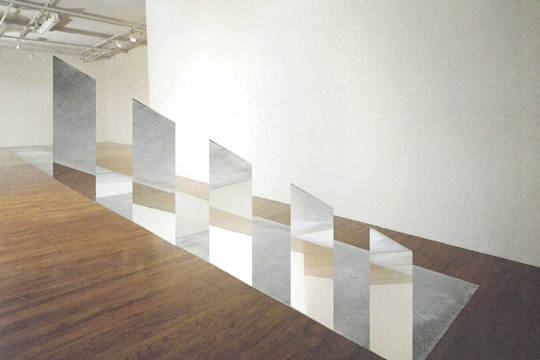GUO HONGWEI: EDITING
| July 19, 2013 | Post In LEAP 21

In 2011, Guo Hongwei created three collage works, Shadow in Shadows, The Sunshine Behind the Sunshine, and Highlight of Highlights. His practice fragmented somewhat, and he engaged in various different projects; in a collaboration with an art and fashion magazine, Guo again employed manual, cut-and-paste collage techniques, transforming advertisements into a formal structure, illusory in its effect. However, from a physical perspective, Guo’s practice neither bolsters nor weakens the informational capacity of the 2D print medium—he simply recodes it.
Comparing Guo Hongwei’s previous collage work—such as the three pieces mentioned above—emphasis is placed on the speculative relationships between difference and commonality, produced by the assemblance of resemblance (similar forms). Alongside his concurrent painting practice, Guo becomes a “collector” of representational form. However, in comparison to his painting formal studio experiments, and although they pay closer attention to the temporal and spatial states of light, as well as to the visual discrepancies produced by light reflecting off the surfaces of different materials, their linguistic forms actually possess a passive rhetoric; the artist instead focuses on the powerful subtleties of individual perception, while the material forms projected onto the audience are relatively monotonous. In his recent magazine collaboration, however, Guo appears to adopt a more active approach, which is extended into his recent solo exhibition—made up almost entirely of collage works, the focus of which shifts onto images taken from the books of his favorite artists.
These artists include Robert Smithson, Carl Andre, Félix González-Torres, Olafur Eliasson, and others. Although the concepts behind each are quite different, the uniform rectangular format of the “artist book” creates a sense of distance from which to observe them. With a book, the reader views artworks removed from their physical settings. Instead, he/she is faced with a kind of flattened formal representation of the work. Take the minimalism of Carl Andre, for example, which focuses on the essential textures of materials. In an attempt to present the complete image of the work, the image itself is sacrificed, which in turn creates a different kind of representation— the arrangement of the space itself is magnified. The collages featured in this solo exhibition are active in two senses: not only do they construct illusions out of the artist’s essentially new arrangements, but, more importantly, they break out of the theoretical boundaries outlined by the minimalist, land art, or conceptual art concepts of the artists which feature within them. They are dragged out of their world of recognizable art texts and returned to the living realm of visual perception—to invoke Paul de Man, form is a necessary prerequisite of any theory. In this way, Guo establishes a kind of personal relationship with other artists. Although the exchange sometimes appears somewhat arbitrary, it is still one which springs forth from the artist’s own visual perspective.
According to Guo Hongwei himself, the collage featured in “Editing” consciously avoids the increasingly prevalent “obsessive materiality” of his recent painting. In his most exemplary painting, for example, the material’s “inner form” is more prominent than the formal relationships established by the contrasts of its external representation. In these collages, Guo instead inverts the mutually-reliant relationship between the image and its background—the image is transformed in order to create a multi-dimensional formal space. Although this is still demonstrated via the visual rhetoric of a painter, this painter has, through his application of concept, arrived at a clarity never before seen.

